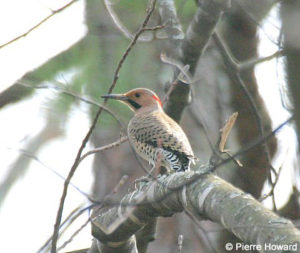(Colaptes auratus – Linnaeus)

Northern Flickers are fairly large, brown woodpeckers. The back of the male of the common flicker is a gray-brown color with broken black bars on the body feathers and with the yellow shafts of the flight feathers partly visible. The rump patch is white and the two-pointed tail is mainly black. The crown and back of the neck is gray with a red band at the nape. The cheeks are pinkish-buff with a black “moustache” and bib below the chin on the throat. The underparts are creamy with many, irregular black spots. The undersides of the wings and tail are bright yellow. The female differs from the male in that she does not have the “moustache”. Both sexes have gray legs, a dark gray bill and dark brown eyes. They are about 12.5 in. long, weigh about 4.5 oz. And have a 20 in. wingspan.
Flickers prefer open habitats near trees, (rather than dense forests) including woodlands, edges, yards, and parks. Flickers eat mainly ants and beetles. Although they eat fruits, berries, seeds and nuts, their primary food is insects. Ants alone can make up 45% of their diet. Flickers often go after ants underground (where the nutritious larvae live), hammering at the soil the way other woodpeckers drill into wood.
Their breeding habitat consists of forested areas across North America and as far south as Central America. They are cavity nesters who typically nest in trees but they will also use posts and birdhouses if sized and situated appropriately. They prefer to excavate their own home although they will reuse and repair damaged or abandoned nests. It takes about 1 to 2 weeks to build the nest which is built by both sexes of the mating pairs. The entrance hole is roughly 2. 5 to 3.9 in. wide and 13 to 16 in. deep. The cavity widens at bottom to make room for eggs and the incubating adult. Inside, the cavity is bare except for a bed of wood chips for the eggs and chicks to rest on. A typical clutch consists of 6 to 8 eggs whose shells are pure white with a smooth surface and high gloss. Incubation is by both sexes for approximately 11 to 12 days. The young are fed by regurgitation and fledge in about 25 to 28 days after hatching.
Northern birds migrate to southern parts of the range; southern birds are often permanent residents.
Click image for more information.
Fun Facts
They have been observed breaking into cow patties to eat insects living within.
Their tongues can dart out 2. in. beyond the end of the bill to snare prey.
As well as eating ants, flickers have a behavior called anting, during which they use the acid from the ants to assist in preening, as it is useful in keeping them free of parasites.
Flickers are the only woodpeckers that frequently feed on the ground,
The berries of poison ivy are one of their favorite berries.
Flickers are reported to eat more ants than any other American bird.
Interested in attracting Flickers?
Northern Flicker numbers have declined over the past 20 years. This decline is thought to result from a combination of factors, including intense competition with the European Starling for nest sites and reduction in possible nest sites due to the removal of dead and dying trees.
Feeding habits of the flicker make it reasonably easy to produce food items that are attractive. Production of berries, nuts and seeds will attract other types of birds also. Since this bird will use a nest box for nesting, it lends itself to this phase of management by providing such sites. A box for a flicker should have a 7 x 7 inch floor, be 16 to 18 inches deep and have a 2 1/2 inch diameter entrance located 2 inches from the top. It should be located 6 to 20 feet above ground. The bottom should be covered with wood chips to a depth of 2 inches.
Click the following to got to site with downloadable plans in PDF format for a flicker house. Flicker House Plans

